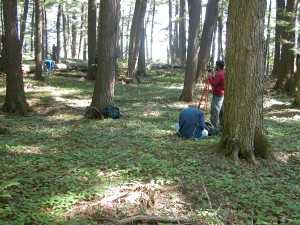A new publication by Dr. Kerry Woods, Bennington College, uses long-term study plots at the Huron Mountains to gain unique insight into the carbon status of old-growth hemlock-northern hardwood forests. The combined living and dead biomass/carbon pools in the stands sampled are very large for eastern North America, but dynamics over nearly 50 years suggest that predicting trends will be difficult.
There are very few good estimates of biomass density (kg of biomass, living and dead, per unit area) for old-growth forests. There are several reasons for that, but the most obvious is that there are not many pieces of old-growth forests to measure. There is even less clarity about whether such forests show long-term trends in biomass density or are stable. Despite a good deal of speculation as to whether old-growth forests are ‘carbon sinks’ (increasing biomass) or ‘carbon sources’ (decreasing biomass), the data required for estimating biomass density over multi-decade time-frames are exceedingly scarce.
21 plots, established in 1962 by Eric Bourdo (Michigan Technological University) in the old-growth stands of the Huron Mts., and followed, since 1989 by Kerry Woods and his collaborators, offer a chance to address questions about the biomass/carbon status of these ‘reference ecosystem’ forests.
Currently, living, aboveground biomass on these plots averages about 400 Megagrams/hectare (about 200 tons/acre). Snags and downed dead trees add about another 50 Mg/ha (25 tons/acre). These values are higher than
any other estimates for eastern forests north of the southern Appalachians. However, while values have shown large fluctuations from decade to decade, there’s no clear indication that total biomass is changing. One notable trend, though, is that the proportion of biomass accounted for by very large trees has increased substantially. Since an individual large tree dying can make a large decrease in plot-level biomass, that suggests that fluctuations might be expected to increase even more in the future.
The paper presenting this work has been accepted for publication in ‘PeerJ’ — an online, open-access, peer-reviewed journal. Once published, it will be freely accessible to anyone (and I’ll post the link).

